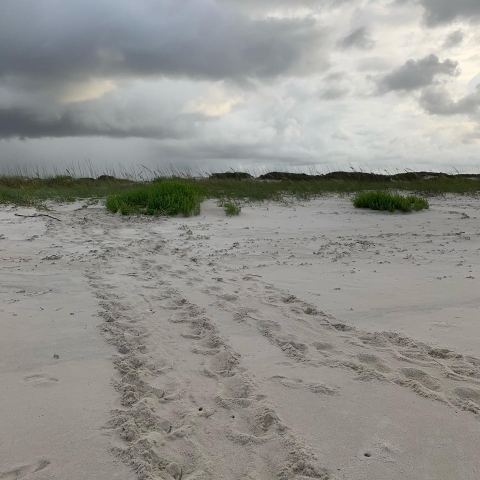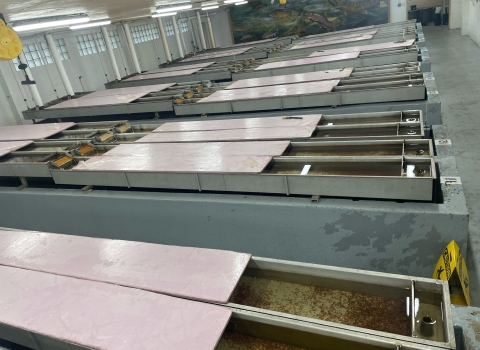Laguna Key, Alabama - Just before the sun rises, you can find Kathy Adams and her team of volunteers scouring the sugar-white beaches of Laguna Key for signs of nesting sea turtles. Adams is a team leader for Share the Beach, a group of men and women committed to keeping Alabama’s sea turtle population intact. Her team spends each morning looking for evidence of sea turtle nests. This means walking along miles of beach and looking for special marks (tracks) in the sand.
To address Covid-19 concerns, “I have my patrol team text me with their temperatures prior to our meeting. When on patrol, we walk about a mile directly on the water’s edge and patrol the tide line searching for crawls,” said Adams.
A crawl is an impression in the sand made by sea turtle flippers as they make their way across the beach to find a good nesting spot. “When a crawl is located, the volunteers will follow it to look for a body pit— evidence that the turtle laid the nest,” explained Shannon Holbrook, biologist with the U.S. Fish and Wildlife Service’s Alabama Field Office.
“If a body pit is located, the team leader will direct the careful digging of sand to locate the eggs. Once the eggs are located and confirmed, they are then recovered with sand, and a predator screen placed directly over the center of the nest. The corners will be staked and the nest will be flagged and marked for future monitoring.”
Unfortunately, not all sea turtle crawls lead to a nest. Sometimes, the female decides to go back into the Gulf without laying eggs, which is known as a false crawl.
This year, volunteers have counted a record number of false crawls. At more than 110 and counting, the false crawls outnumber the actual nests, which are holding at 85.
“There are many things that can make her not nest; bright lights from homes, condos or people on the beach,” explained Adams.
“The turtle is looking for a good spot to dig and deposit her eggs. Sometimes, the female is a first time nester and may not quite be ready yet,” said Holbrook.
When Alabama Governor Kay Ivey ordered the beaches closed in March, Holbrook thought the tourist-free sand would attract a high number of nesting sea turtles. When the beaches reopened at the end of April, visitors came flocking back in.
“While we love to see our visitors enjoy the beaches, we would ask for their help in reducing impacts on sea turtles so they can successfully nest. Turtles prefer dark, quiet and empty beaches to nest,” said Holbrook.
Sea turtles depend on the natural light of the moon to navigate in and out of the water at night. Artificial lighting from condominiums, houses and businesses, and even concentrations of bright flash lights on the beach can confuse and disorient the nesting turtle. This can result in her not nesting, becoming stranded or even dying. That’s why Holbrook has teamed up with Share the Beach and the Alabama Coastal Foundation in a campaign to help keep the beaches dark, even at the height of tourist season.
“For several years now, we have been documenting problem beachfront lighting sources and have reached out to businesses, condos and vendors to eliminate problems that unnecessarily impact nesting and hatching sea turtles,” said Holbrook.
Holbrook and her partners have held multiple workshops to show vendors how to retrofit their lights to make them sea turtle friendly. The lights should be low, shielded and red or amber in color.
Most recently, Holbrook has worked with officials at Gulf State Park in Baldwin County to help retrofit the lights on the largest pier on the Gulf Coast. The pier was closed for renovations in May.
Kelly Reetz is a naturalist with Gulf State Park. She said meeting the needs of visitors and keeping the pier environmentally friendly have always been a balancing act.
“Gulf State Park’s iconic pier is visited by more than 85,000 people each summer. Since the pier is open 24 hours a day, we face many challenges managing the safety of our guests while simultaneously respecting the sensitive needs of wildlife that call the beach their home,” said Reetz.
Thanks to changes in technology, Reetz says the new lights are a win for wildlife and people.
“Our turtle-friendly lights now produce less lumens; new light shields keep light on the pier, and lower light poles bring the light closer to guests.” explained Reetz.
“Additionally, in the parking lot, we were able to further reduce the existing light pollution by lowering the light poles, from the standard 20 feet, to approximately 14 feet from the ground. We are proud to do our part to better protect wildlife and educate our visitors about the importance of conservation on our beautiful beach.”
Lighting from development isn’t the only problem nesting sea turtles face. As thousands of tourists hit the beach, human interaction with a nesting sea turtle is inevitable; It’s not unusual for a beach goer to witness a sea turtle emerging from the water. Sometimes the excitement of the moment can deter the turtle from nesting.
“People on the beach could easily turn the turtle back into the water, especially if they have bright lights,” said Adams.
Share the Beach volunteers have captured pictures of tourists shining their flashlights directly in a turtle’s face. One disturbing video shows someone dancing over the turtle. Not only does this behavior negatively impact the species, it is against the law.
“All sea turtles that nest on Alabama’s beaches are federally threatened or endangered species, and sea turtles, their eggs, and nests are provided protection under the Endangered Species Act. Any activity that results in injury or death to sea turtles, disorientation of nesting and hatchling sea turtles by artificial lighting, or otherwise significantly alters the behavior of sea turtles, may constitute a violation under the take prohibitions of the Endangered Species Act.” explained Holbrook.
Holbrook is just getting started on her mission to educate folks on nesting sea turtles. As more false crawls are discovered, and more leaked videos of sea turtle harassment are in the hands of authorities, it’s clear to her more work needs to be done.
“Remember, there is a way to use and enjoy the beach and keep it sea turtle friendly. If everyone does their part, we can enjoy this species for years to come.”
Observing a sea turtle on the beach at night is a once in a lifetime experience. Please act responsibly and be respectful of our native wildlife by following the below recommendations:
- Avoid using bright, white flashlights on the beach. Find a flashlight that emits a long wavelength red or amber light or use a red filter over your regular flashlight.
- Fill in any holes that you dig during the day and remove all beach equipment such as tents and chairs, at night.
- If you are fortunate enough to see a sea turtle on the beach, do not disturb her. Turn out all lights, stay low, quiet and behind her, maintaining a minimum of 30 foot distance.
- Do not disturb sea turtle nests, including stepping into a marked nest area or digging into the nest.
- Call (866) SEA-TURTLE to report a nesting sea turtle.





